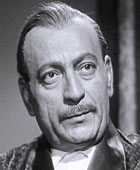Salladin the Victorious
Saladin the Victorious Arabic , translit.Al Nasser Salah AdDin is a 1963 Egyptian film, written by Youssef El Sebai, based on the novel by Naguib Mahfouz and directed by Youssef Chahine. The film stars Ahmed Mazhar as Saladin, Salah Zulfikar, Mohamed Abdel Gawad, Tewfik El Dekn, Omar ElHariri, Mahmoud ElMeliguy, Leila Fawzi, Hamdi Gheiss, Ahmed Luxor, Nadia Lutfi, Hussein Riad, Laila Taher and Zaki Toleimat. It was entered into the 3rd Moscow International Film Festival.
For some historical context, the movie depicts the events of the Third Crusade. What happens during those events is that after Saladin reclaimed Jerusalem, the European powers led by King Richard of England, Emperor Barbarossa of Germany and King Phillip Augustus of France joined together to reclaim it and return it to Christian hands. This resulted in the war between the Europeans and Saladin, which lasted for three years before a truce was made between Saladin and King Richard, allowing Saladin to keep the land while Christians could freely enter Jerusalem.When the movie came out, it came at a time when Egypt was free of colonial rule and was released between two wars with Israel. Due to this, the Egyptian government was trying to promote its ideals, with the leader at the time, Gamal Abdel Nasser, being the representative of it. Saladin in many ways references and parallels Nasser as like the president, the movie Saladin pushes forth the ideal of a Pan Arab unity as all Arabs are united in the movie in fighting the European powers, which is no better portrayed then in the line My dream is to see an Arab Nation under one flag, hearts united and free of hate. This is also portrayed well with Issa, whos an Christian Arab, yet chooses to fight alongside Saladin and his army. Similarly, it also has an anticolonialism message as the European powers are trying to subjugate the Arab lands under their rule, but they resist and successfully manage to peacefully resolve the war. This is shown in showing the bronze Arabs pulling siege towers at the head of the Crusader army, the Arabs represent those who remain in oppression under imperialistic rule while the mechanical siege towers represent the warlike machines that were present in the battles Egypt fought for their independence. ........
Source: Wikipedia



